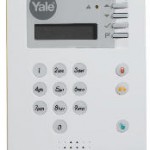AD Alarms are professional installers of many brands of wireless security alarms but we specialise in the Yale alarm.
Here are some step-by-step tips pointing out faults that can occur in a minority of installations along with the remedies. This kind of knowledge would only be known by the regular installers of the equipment and so can be very useful to the DIY first-time installer.
We don’t want to put customers off the Yale Alarm, we think it is the best value for money wireless alarm on the market, it’s just that every make of alarm has its own individual idiosyncrasies which can waste time and put people off if they are not aware of the facts.
Yale Alarm’s are Installed throughout the UK by AD Alarms based in Bradford and Leeds
Firstly when wireless magnetic contacts are fitted to UPVC plastic doors, on a minority of occasions they do not the work. The reason is the inner core of the door is sometimes made of metal which affects the transmission of the wireless contact.
The best practice is to put the control panel into walk test and then take the wireless contact to the location of the door and press the test button or hold the magnetic contacts in your hands and part the magnet from the sensor. Obviously everything should be fine so long as the contacts are within the 30 meter range of the main control panel. There is occasionally this situation that once they are actually physically on the door they cease to work. The only remedy is to try moving the contacts to different parts of the door or taking the contact transmitter off the door a little with a thin piece of wood or plastic, but it doesn’t always work. I will stress again that this problem with these UPVC doors is only an extremely small minority of situations. The best alternative under this situation where contacts are not used on the external door is to make sure that at least there is a passive infrared pointing at the door.
Full Yale Premium Alarm (with autodialler) FITTED 1-year guarantee Click for www.ADAlarms.co.uk
Full Yale Standard Alarm FITTED 1-year guarantee
AD Alarms based in Bradford and Leeds, install, Service, and Repair Wired and, Wireless Alarms and CCTV throughout the United Kingdom. Just contact us for friendly advice on telephone number
– Mobile 07813 779273 – E-mail sales@adalarms.co.uk
11 Albion Road Idle Bradford BD109PY Click for www.ADAlarms.co.uk
The second problem that can occur is with the passive infrared sensors, but once again this is a very small minority of situations. The passive infrared sensors have a range of 30 meters also, but if the sensor is in a position where there are a number of walls between the sensor itself and the main control panel, especially if these walls have metal framed windows and doors, it can stop the sensor working.
Internally in a property like a house usually the passive infrared transmission pathway back to the main control panel will only have to pass through one or two walls with no metal window frames, so almost always works perfectly.
A real-life example of a situation where this infrared problem occurred to A.D. Alarms was when we installed a passive infrared into an external garage about 25 meters away, which should still have been in range. The problem was that the transmission pathway from the passive infrared in the garage to the main control panel in the house was at a very steep angle and passing through a metal window frame and door frame of the external wall of the house. The passive infrared in the garage didn’t work, but the remedy was to move the sensor inside the garage to a new position where the angle of the transmission signal from the sensor back to the house was different and it then worked. As previously stated this problem is not very common.
The second problem is really not a problem at all; it is that the passive infrared sensors in a room where people are moving around go to sleep, meaning that the red LED and the sensor does not operate constantly when people are moving around inside a room, this is just to conserve battery power. On leaving the room you should wait a couple of minutes before re-entering the passive infrared will still be in sleep mode and not operate.
Once people have left the room empty the sensor switches from sleep mode back to normal mode so that it will operate as soon as the first person enters the room. This going to sleep condition of the passive infrared is made very clear in the instruction manual but sometimes missed by the DIY installer.
The self-acting siren box which goes outside has anti-tamper springs and micro switches on both the front cover and the rear backplate, but the spring on the backplate can be susceptible to falling into recesses in the external wall, especially if it is the type of brickwork which has a very uneven frontage. The best thing to do is to find a wider than the spring piece of thin plastic or any other material which will not degenerate outside and to slide up into the position where the anti-tamper spring is going to rest against a wall, and use a small amount of insulation tape against the wall. There is now much less likelihood of the spring being able to fall into a wall recess causing an anti-tamper fault. Obviously, if the siren box was tampered with by an intruder, the tamper spring would still pop out triggering the alarm system.
We Install, Service, and Repair Wired Alarms, Wireless Alarms, and CCTV throughout the UK. Just contact us for friendly advice
Full wireless premium security alarm (with autodialler) fully inclusive 1-year guarantee
Full wireless standard security alarm FITTED
E-mail alan@adalarms.co.uk – Telephone Bradford 01274 614650 – Mobile 07813779273


